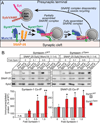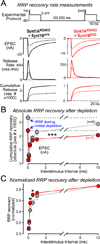Microsecond dissection of neurotransmitter release: SNARE-complex assembly dictates speed and Ca²⁺ sensitivity
- PMID: 24908488
- PMCID: PMC4109412
- DOI: 10.1016/j.neuron.2014.04.020
Microsecond dissection of neurotransmitter release: SNARE-complex assembly dictates speed and Ca²⁺ sensitivity
Abstract
SNARE-complex assembly mediates synaptic vesicle fusion during neurotransmitter release and requires that the target-SNARE protein syntaxin-1 switches from a closed to an open conformation. Although many SNARE proteins are available per vesicle, only one to three SNARE complexes are minimally needed for a fusion reaction. Here, we use high-resolution measurements of synaptic transmission in the calyx-of-Held synapse from mutant mice in which syntaxin-1 is rendered constitutively open and SNARE-complex assembly is enhanced to examine the relation between SNARE-complex assembly and neurotransmitter release. We show that enhancing SNARE-complex assembly dramatically increases the speed of evoked release, potentiates the Ca(2+)-affinity of release, and accelerates fusion-pore expansion during individual vesicle fusion events. Our data indicate that the number of assembled SNARE complexes per vesicle during fusion determines the presynaptic release probability and fusion kinetics and suggest a mechanism whereby proteins (Munc13 or RIM) may control presynaptic plasticity by regulating SNARE-complex assembly.
Copyright © 2014 Elsevier Inc. All rights reserved.
Figures







References
-
- Augustin I, Rosenmund C, Südhof TC, Brose N. Munc13-1 is essential for fusion competence of glutamatergic synaptic vesicles. Nature. 1999;400:457–461. - PubMed
-
- Bezprozvanny I, Scheller RH, Tsien RW. Functional impact of syntaxin on gating of N-type and Q-type calcium channels. Nature. 1995;378:623–626. - PubMed
-
- Bollmann JH, Sakmann B. Control of synaptic strength and timing by the release-site Ca2+ signal. Nat Neurosci. 2005;8(4):426–434. - PubMed
-
- Bollmann JH, Sakmann B, Borst JG. Calcium sensitivity of glutamate release in a calyx-type terminal. Science. 2000;289:953–957. - PubMed
Publication types
MeSH terms
Substances
Grants and funding
LinkOut - more resources
Full Text Sources
Other Literature Sources
Molecular Biology Databases
Miscellaneous

